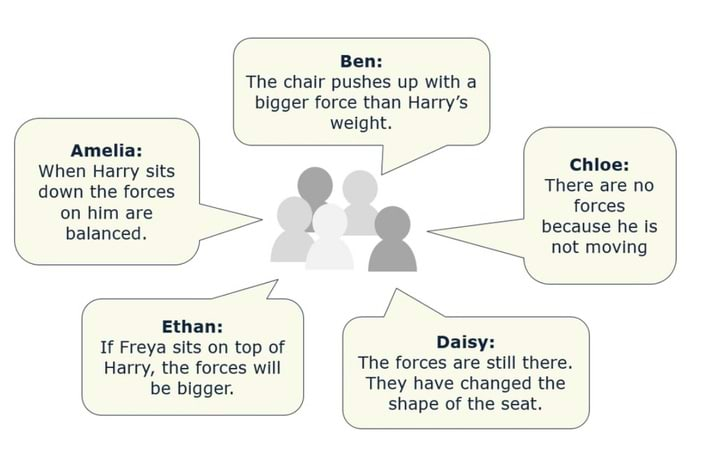Learning focus: | The resultant force is the sum of the forces acting on the object, taking into account their direction. If there is no resultant force, the forces are balanced. Unbalanced forces change the speed, direction and/or shape of an object. |
Observable learning outcome: | Describe what happens when two equal sized forces act on an object, both acting along the same straight line but in opposite directions. |
Activity type: | Diagnostic, simple multiple choice |
Key words: | Balanced forces |
Driver et al (1994) identify several common misunderstandings that are addressed by this question:
- if there is motion, there is a force acting
- if there is no motion, then there is no force acting
- there cannot be a force without motion
The first of these is very widely held because in everyday experience, when cycling or driving for example, we do need to apply a constant force in order to move at a steady speed in order to match friction and air resistance. This means that when an object is not moving it is wrongly perceived to have no force acting on it and the other misunderstandings can follow. Indeed, Driver et al (1994) point to a study of 1000 Norwegian upper secondary students, by Sjoberg and Lie (1981), which found just 50% of the young people recognised ‘passive’ forces acting when there was no movement.
This response activity engages students in considering the forces acting when sitting stationary on a chair.
Students should complete this activity in pairs or small groups, and the focus should be on the discussions. The statements are also provided as cut-out cards for students to physically organise.
Students should work together to follow the instructions on either the worksheet or the PowerPoint. Giving each group one worksheet to complete between them is helpful for encouraging discussion, but each member should be able to report back to the class. Listening in to the conversations of each group will often give you insights into how your students are thinking.
If there is disagreement when you take feedback, a good way to progress might be through structured class discussion. Ask one student to explain why they gave the answer they did; ask another student to explain why they agree with them; ask another to explain why they disagree, and so on. This sort of discussion gives students the opportunity to explore their thinking and for you to really understand their learning needs.
Differentiation
The quality of the discussions can be improved with a careful selection of groups; or by allocating specific roles to students in the each group. For example, you may choose to select a student with strong prior knowledge as a scribe, and forbid them from contributing any of their own answers. They may question the others and only write down what they have been told. This strategy encourages contributions from more members of each group.
Amelia, Daisy and Ethan are correct. Ben is thinking of the chair as a barrier to Harry falling to the floor, which breaks if the force on it is too big. In fact when Harry sits down the chair flexes enough to give a ‘spring’ force that matches his weight. The heavier the person, the bigger the flex and the bigger the upwards push.
Chloe has linked the lack of movement with there being no force. Demonstrating the balloon from the diagnostic question: What changes can help her to understand that there are still forces.
The BEST physics topic PFM3: More about forces develops students’ understanding of reaction forces. At this stage the important concept for students is that forces continue to act in situations where they are balanced.
Driver, R., Squires, A., Rushworth, P. and Wood-Robinson, V. (1994) Making sense of secondary science, research into children’s ideas, Routledge, London, England.
Sjoberg, S. and Lie, S. (1981) Ideas about force and movement among Norwegian pupils and students, Institute of Physics Report Series: Report 81-11, University of Oslo.

